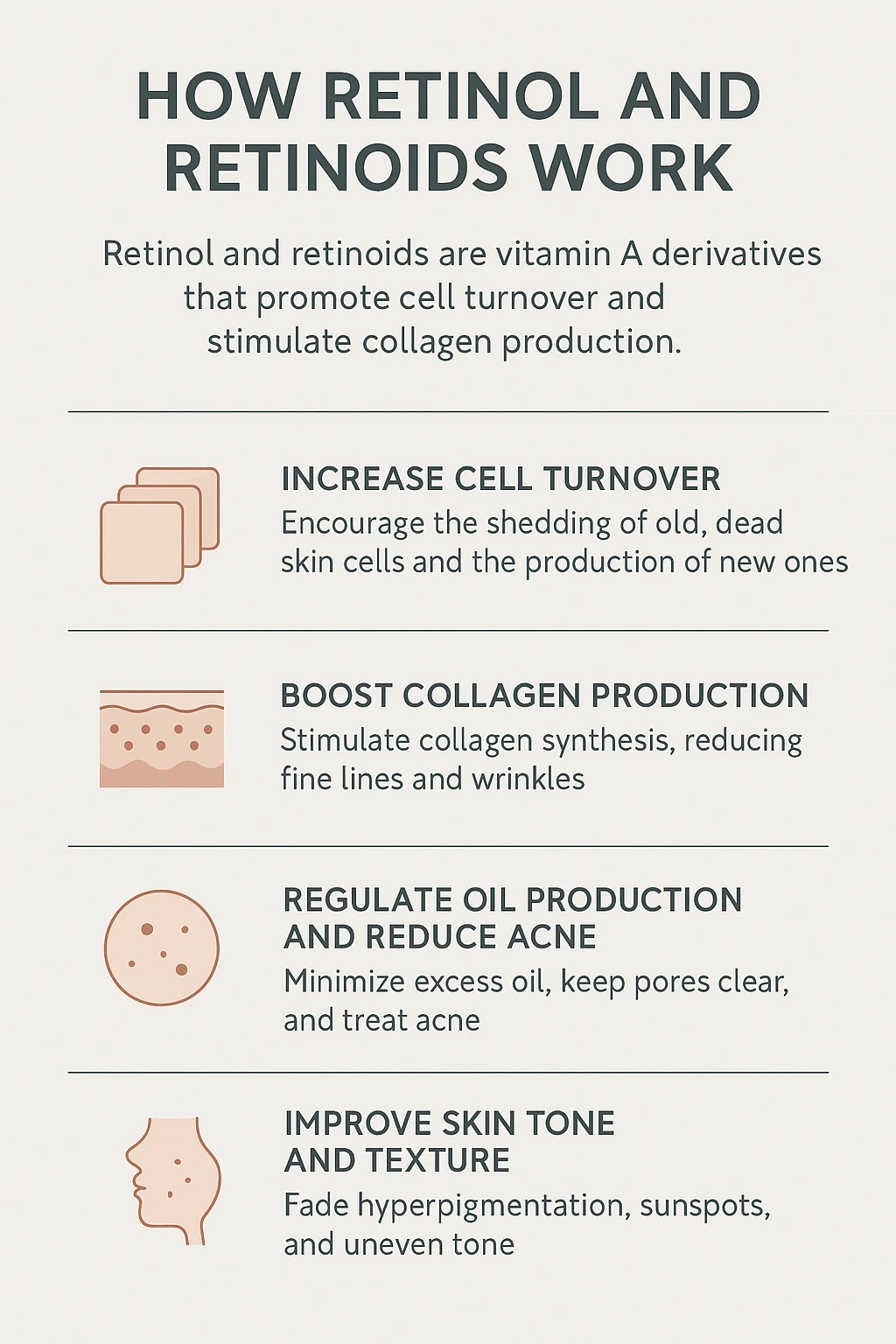How do retinol and retinoids work?
Retinol and retinoids are powerful skincare ingredients derived from vitamin A, widely recognized for their effectiveness in improving skin texture, reducing signs of aging, and treating acne. Though often used interchangeably, the terms refer to different forms and strengths of the same vitamin A family.
What Are Retinoids and Retinol?
-
Retinoids is the umbrella term for all vitamin A derivatives, including prescription-strength options like tretinoin and adapalene, as well as milder over-the-counter forms like retinol, retinaldehyde, and retinyl esters.
-
Retinol is a type of retinoid available without a prescription. It’s gentler and slower-acting but still effective with consistent use.
How Do They Work?
Retinol and retinoids promote cell turnover and stimulate collagen production, making them highly effective in addressing various skin concerns. Here's how they work on a biological level:
-
Increase Cell Turnover
Retinoids encourage the skin to shed old, dead skin cells and produce new ones more rapidly. This process helps keep pores clear, smoothens skin texture, and gives the complexion a more youthful, radiant look. -
Boost Collagen Production
As we age, collagen—the protein that keeps skin firm and elastic—naturally breaks down. Retinoids help stimulate collagen synthesis, which can reduce the appearance of fine lines, wrinkles, and sagging. -
Regulate Oil Production and Reduce Acne
Retinoids minimize excess oil production and prevent clogged pores, which is why they're often used to treat acne. They also help fade post-acne marks over time. -
Improve Skin Tone and Texture
With regular use, retinoids can reduce hyperpigmentation, sunspots, and uneven skin tone, helping to brighten and smooth the skin.
Types and Strengths
| Form | Description | Strength |
|---|---|---|
| Retinyl esters | Weakest form; requires several conversions to become active | Mild |
| Retinol | Common OTC form; effective over time | Moderate |
| Retinaldehyde | Converts more quickly than retinol | Moderate |
| Tretinoin (Retinoic acid) | Prescription-only; directly active | Strong |
| Adapalene | Synthetic retinoid, OTC or Rx; good for acne | Moderate to Strong |
Stronger forms work faster but may cause more irritation, especially for sensitive skin.
Side Effects and How to Use
Common side effects include:
-
Dryness
-
Redness
-
Flaking
-
Initial breakout or “purging”
To minimize irritation:
-
Start with a low concentration and apply every other night.
-
Use a pea-sized amount for the whole face.
-
Moisturize well and use sunscreen daily, as retinoids make skin more sun-sensitive.
-
Avoid combining with harsh ingredients like AHAs, BHAs, or benzoyl peroxide until your skin adjusts.
Final Thoughts
Retinol and retinoids are clinically proven to improve skin texture, tone, and clarity. While results take time—usually 6–12 weeks of consistent use—they are worth the wait for many users. The key is to choose the right form and strength for your skin type and introduce it gradually. When used properly, retinoids can be transformative, helping you achieve smoother, clearer, and younger-looking skin.

Related Blog
What Causes Oily Skin and Can It Be Managed Naturally? Exploring Root Causes and Gentle Solutions
Aug 2, 2025 by Admin
General
What Are the Signs That You Have Sensitive Skin? Key Symptoms to Help You Identify This Delicate Skin Type
Aug 1, 2025 by Admin
General